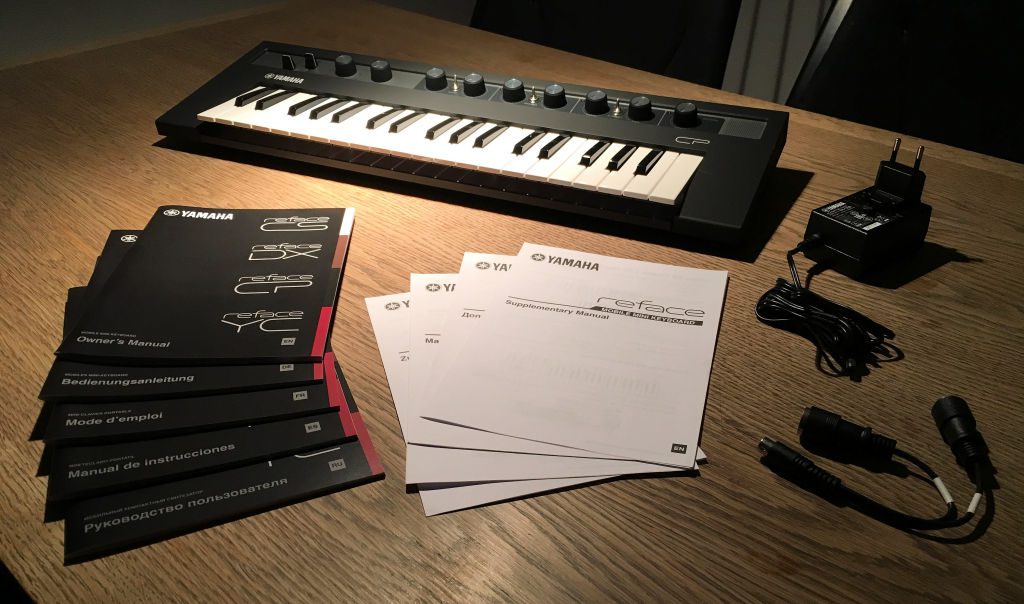After creating my first SID tune in 25 years, I knew I had to get some sort of keyboard to test out leaders and chords. I didn’t want to get a big one as I didn’t have much room on my desk, and I didn’t expect to spend hours solely performing on it as I’m not brilliant at that anyway. A tiny one just to test out stuff would be just fine with me.
Luck had it that just a few streets away from my workplace in the center of Copenhagen, there was a renowned keyboard shop with tons of keyboards of all types and sizes. After checking things out for a while, I quickly decided not to get a small MIDI keyboard. These kinds of things tend to want an external sound source and I wanted it to have its own sound and loudspeakers.
That’s when the new Yamaha Reface series caught my eyes.
Yamaha launched a series of these four mini keyboards as sort of a tribute to their classic keyboards. All have the same size, the same keys and the same ports in the back, but the controls in the top row and the sound is very different across them. Apart from playing around on them in the shop, I also watched a few videos on YouTube and read review blogs. I like to do my research before I reach for the credit card.
The red YC has an old organ sound with Leslie emulation. Think old grandmother organ. This appeared to be the only one of the four that didn’t have touch sensitivity in its keys, and that was an instant turn-off for me. It made it feel sub par compared to the other keyboards, as if they had cut out a vital part of the tech inside of it – yet it still had the same price tag. Bummer. Also, a red casing? Yeech!
The white CS had a raw sound with basic FM and ring modulation. It reminded me a bit of the SID and somehow that in itself turned me off too. Having the same sound as the SID tunes I was trying to create felt to me like doing double work. Maybe I would hit a nice sound on the keyboard I knew was possible in SID, but then I would have to try and work the numbers to catch that sound all over again.
In hindsight, that might have been the wrong conclusion. Also, it has a pitch bender I actually miss.
The two keyboards I ended up choosing between was the DX and CP. The DX was based on the good old DX7 and had FM with waveform morphing. It was also the only one of the four that could actually program and store instruments. What eventually swayed me away from it was those weird touch sensitive sliders. It smelled like futuristic controls but I was afraid they wouldn’t work as well as normal sliders.
In the end I decided to go with the CP for several reasons. It had a good modern organ sound with reverb, delayed echos, tremolo/phaser, etc. I liked how no-nonsense this was, not having to learn how to program and store anything. Sheer performing and testing. The reviewers in the blogs I found also tended to favor this keyboard as their choice as well. And finally, it had a nice, black design I liked.
YouTube have videos where you can hear what the Yamaha CP sounds like.
I used the keyboard mostly to test chords and count their tonal offsets for typing into the music editor while making my second SID tune. The knobs and controllers makes for a nice palette of effects, delay, reverb and phasing, but it’s true that the breadth of sounds possible is not enormous. The keys are touch sensitive and are precise but also feel a lot like the plastic keys they really are.

Probably the most impressive part of the keyboard is the range of outputs in its back. It has MIDI, USB, sound outputs for L/R, phono and aux in, and even for a sustain pedal. It comes with a power supply but also takes batteries, and it automatically powers off after a while of inactivity. It also has the capability of overriding or presetting by holding down a specific key while powering it up.
I must say that I’m happy with the keyboard for what I’m using it for but if I have to be absolutely honest, I think it was just a tad too expensive. All of the four keyboards had the same price tag, which in the Danish shop was around 3000 kr. – or about 340 dollars. Given the plastic feel of the small keys and the limited amount of sounds possible, it should probably not have been more than 60-70% of that at the most.
I guess you pay for the name, the tribute, and for the outputs in the back.
If you have found this blog post with the idea of also buying one of these keyboards, I really recommend you find videos on YouTube and also test them out for yourself in a shop. They all have their charms and choosing one may be up to what kind of sound you really prefer yourself. Also, if you plan on actually playing and performing, perhaps you’d be better off with a full size keyboard.




It’s a great keyboard and seems to have held its value better than others in the Reface series.
Look up the hidden Acoustic Piano mode if you haven’t already found it. 🙂